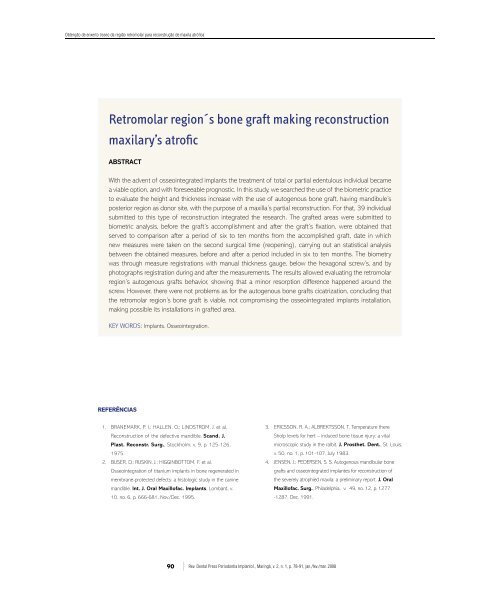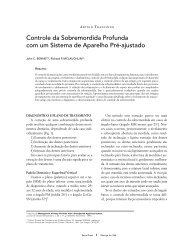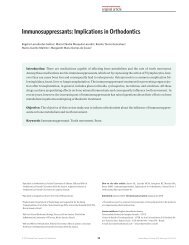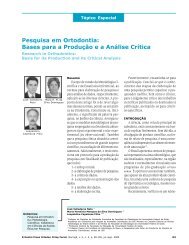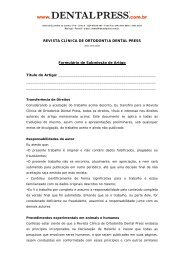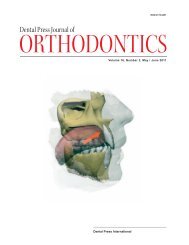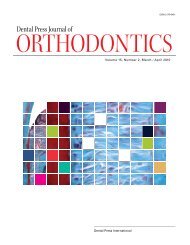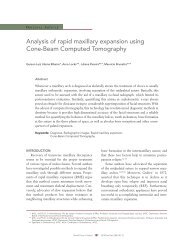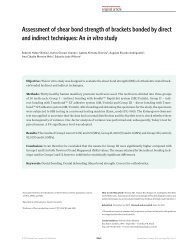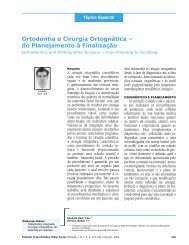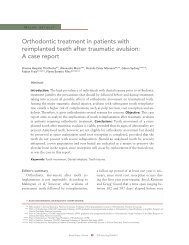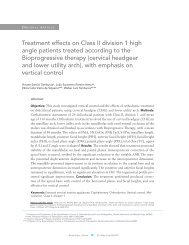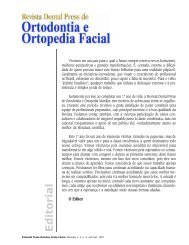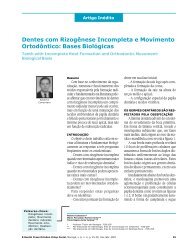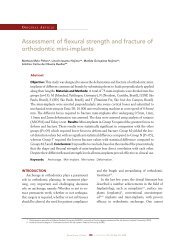Obtenção <strong>de</strong> enxerto ósseo da região retromolar para reconstrução <strong>de</strong> maxila atrófica Retromolar region´s bone graft making reconstruction maxilary’s atrofic aBStRaCt With the advent of osseointegrated implants the treatment of total or partial e<strong>de</strong>ntulous individual became a viable option, and with foreseeable prognostic. In this study, we searched the use of the biometric practice to evaluate the height and thickness increase with the use of autogenous bone graft, having mandibule’s posterior region as donor site, with the purpose of a maxilla’s partial reconstruction. For that, 39 individual submitted to this type of reconstruction integrated the research. The grafted areas were submitted to biometric analysis, before the graft’s accomplishment and after the graft’s fixation, were obtained that served to comparison after a period of six to ten months from the accomplished graft, date in which new measures were taken on the second surgical time (reopening), carrying out an statistical analysis between the obtained measures, before and after a period inclu<strong>de</strong>d in six to ten months. The biometry was through measure registrations with manual thickness gauge, below the hexagonal screw’s, and by photographs registration during and after the measurements. The results allowed evaluating the retromolar region’s autogenous grafts behavior, showing that a minor resorption difference happened around the screw. However, there were not problems as for the autogenous bone grafts cicatrization, concluding that the retromolar region’s bone graft is viable, not compromising the osseointegrated implants installation, making possible its installations in grafted area. KEY WORDS: Implants. Osseointegration. REFERêNCIAS 1. BRANEMARK, P. I.; HALLEN, O.; LINDSTROM, J. et al. Reconstruction of the <strong>de</strong>fective mandible. Scand. J. Plast. Reconstr. Surg., Stockholm, v. 9, p. 125-126, 1975. 2. BUSER, D.; RUSKIN, J.; HIGGINBOTTOM, F. et al. Osseointegration of titanium implants in bone regenerated in membrane-protected <strong>de</strong>fects: a histologic study in the canine mandible. Int. J. Oral Maxillofac. Implants, Lombard, v. 10, no. 6, p. 666-681, Nov./Dec. 1995. 3. ERICSSON, R. A.; ALBREKTSSON, T. Temperature there Sholp levels for hert – induced bone tissue njury: a vital microscopic study in the ralbit. J. Prosthet. Dent., St. Louis, v. 50, no. 1, p. 101-107, July 1983. 4. JENSEN, J.; PEDERSEN, S. S. Autogenous mandibular bone grafts and osseointegrated implantes for reconstruction of the severely atrophied maxila: a preliminary report. J. Oral Maxillofac. Surg., Phila<strong>de</strong>lphia, v. 49, no. 12, p. 1277 -1287, Dec. 1991. 90 Rev. <strong>Dental</strong> <strong>Press</strong> Periodontia Implantol., Maringá, v. 2, n. 1, p. 78-91, jan./fev./mar. 2008
Luiz Gustavo Garla Matocano, Maysa Sella Saraiva 5. JENSEN, J.; SINDET-PEDERSEN, S.; OLIVER, A. J. Varying treatment strategies for reconstruction of maxillary atrophy wit implants: results in 98 patients. J. Oral Maxillofac. Surg., Phila<strong>de</strong>lphia, v. 52, no. 3, p. 210-216, Mar. 1994. 6. JENSEN, J.; SINDET-PEDERSEN, S.; ENEMARK, H. Augmentation of localized <strong>de</strong>fects of the anterior maxillary ridge with autogenous bone before insertion of implants. J. Oral Maxillofac. Surg., Phila<strong>de</strong>lphia, v. 54, no. 10, p. 1180-1186, Oct. 1996. 7. JENSEN, J.; ENEMARK, H. Reconstruction of residual alveolar cleft <strong>de</strong>fects with one-stage mandibular bone grafts and osseointegrated implants. J. Oral Maxillofac. Surg., Phila<strong>de</strong>lphia, v. 56, no. 4, p. 460-466, Apr. 1998. 8. LUNDGREN, S.; MOY, P.; JOHANSSON, C. et al. Augmentation of the maxillary sinus floor with particulated mandible: a histologic and histomorphometric study. Int. J. Oral Maxillofac. Implants, Lombard, v. 11, no. 6, p. 760-766, Nov./Dec. 1996. 9. MEYER, R. A. Mandibular synphisis as donor site in bone grafting for surgical correction of open bite: report of a case. J. Oral Surg., Chicago, v. 30, no. 2, p. 125-130, Feb. 1972. 10. MISCH, C. M.; MISCH, C. E.; RESNIK, R. R. et al. Reconstruction of maxillary alveolar <strong>de</strong>fects with mandibular synphisis grafts for <strong>de</strong>ntal implants; a preliminary procedural report. Int. J. Oral Maxillofac. Implants, Lombard, v. 7, no. 3, p. 360-366, 1992. 11. MISCH, C. Comparison of intraoral donor sites for onlay grafting prior to implant placement. Int. J. Oral Maxillofac. Implants, Lombard, v. 12, no. 6, p. 767-776, Nov./Dec. 1997. 12. MISCH, C.; DIETSH, F. Endosteal implants and iliac crest grafts to restore severely resorbed totally e<strong>de</strong>ntulous maxillary a retrospective stydy. J. Oral Implantol., Lawrence, v. 20, no. 2, p. 100-110, 1994. 13. OZAKI, W.; BUCHMAN, S. R. Volume maintenance of onlay bone grafts in the craniofacial skeleton: micro architecture versus embryologic origin. Plast. Reconstr. Surg., Hagerstown, v. 102, no. 2, p. 291-299, Aug. 1998 14. PRECIOUS, D. S.; SMITH, W. P. The use of mandibular symphryreal bone in maxillofacial surgery. Br. J. Oral Maxillofac. Surg., Edinburgh, v. 30, no. 3, p. 148-152, June 1992. 15. RAGHOEBAR, G. M.; BATENBURG, R. H.; VISSINK, A. et al. Augmentation of localized <strong>de</strong>fects of the anterior maxillary ridge with autogenous bone before insertion of implants. J. Oral Maxillofac. Surg., Phila<strong>de</strong>lphia, v. 54, no. 10, p. 1180-1185, Oct. 1996. 16. ROCHE, Y. A.; SCHWARTZ, H. C. The mandibular body bone (MBB) graft: an alternative source of membranous bone. J. Cranio Maxillofac. Surg., Edinburgh, v. 21, no. 5, p. 199- 201, July 1993. 17. SAILER, H. F. A new method of inserting endosseous implants in totally atrophic maxillae. J. Cranio Maxillofac. Surg., Edinburgh, v. 17, no. 7, p. 229-305, Oct. 1989. 18. SINDET-PEDERSEN, S.; ENMARK, H. Mandibular bone grafts for reconstruction of alveolar clefts. J. Oral Maxillofac. Surg., Phila<strong>de</strong>lphia, v. 46, no. 7, p. 533-537, July 1988.. 19. SINDET-PEDERSEN, S.; ENMARK, H. Reconstruction of alveolar chefts with mandibular or iliac crest bone grafts: a comparative study. J. Oral Maxillofac. Surg., Phila<strong>de</strong>lphia, v. 48, no. 6, p. 554-558, June 1990. 20. VON ARX, T.; WALLKAMM, B.; HARDT, N. Localized ridge4 augmentation using a micro titanium mesh: a report on 27 implants followed from 1 to 3 years after functional loading. Clin. Oral Implants Res., Copenhagen, v. 9, no. 2, p. 123- 130, Apr. 1998. 21. WIDMARK, G.; ANDERSSON, B.; IVANOFF, C. J. Mandibular bone graft in the anterior maxilla for single-tooth implants: presentation of surgical method. Int. J. Oral Maxillofac. Implants, Lombard, v. 26, no. 2, p. 106-109, Apr. 1997. En<strong>de</strong>reço para correspondência luiz Gustavo Garla Matocano Rua Estados Unidos nº 1178 - Centro CEP: 86.181-100 - Cambé/PR E-mail: clinicasaoluiz@onda.com.br Rev. <strong>Dental</strong> <strong>Press</strong> Periodontia Implantol., Maringá, v. 2, n. 1, p. 78-91, jan./fev./mar. 2008 91


